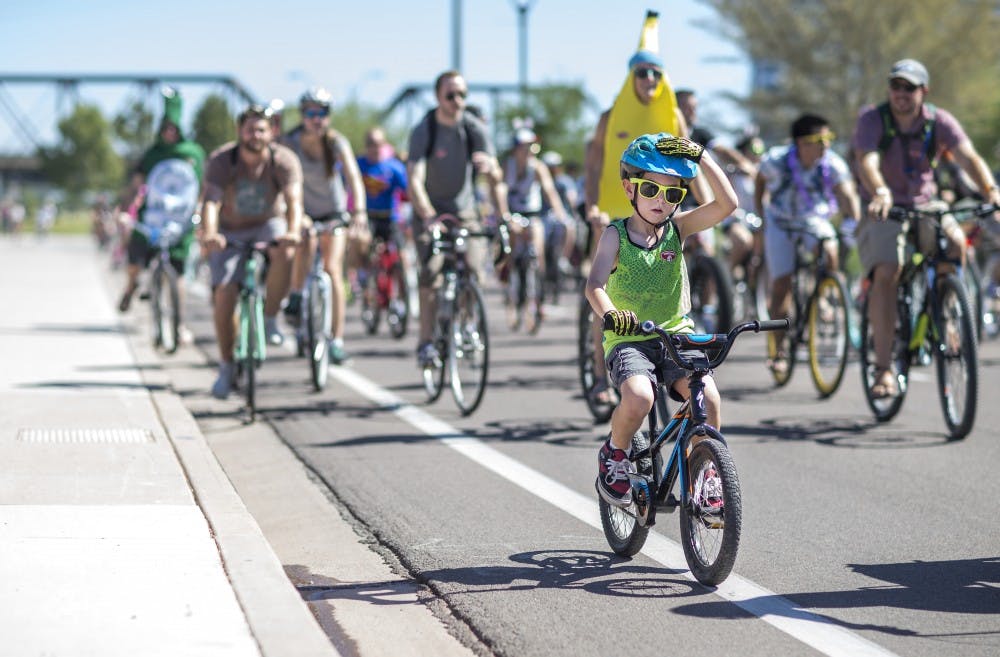In a move that's perfectly timed with the Valley's growing passion for biking, the American Association of State Highway and Transportation Officials has agreed to designate a section of roads and paths as U.S. Bicycle Route 90.
The American Association of State Highway and Transportation Officials, AASHTO, established the USBR system in 1978, and only two routes were officially designated until 2011.
The Adventure Cycling Association, a non-profit organization devoted to bicycle use and awareness, is one of the lead organizers behind the expansion of the USBR system, which designates existing stretches of road and other infrastructure as official bike routes.
Saara Snow, travel initiatives coordinator at the Adventure Cycling Association, said a main part of the USBR system is making cycling in all its forms more accessible.
“It’s essentially to provide officially designated routes between states, and to connect cities, communities and other tourism destinations that people might want to view on a bike tour,” Snow said.
Adventure Cycling submitted to AASHTO what it calls the Corridor Plan, which consists of its own already-designated 44,000 miles of route, plus whatever other state and national routes that could already provide connections between sites.
Snow said she hopes to see 50,000 miles of routes completed when all is said and done, with about 4,000 miles established each year.
Since the roads utilized by the routes belong to many different owners, the main variable is the physical implementation of the routes, which comes in the form of signage. So, whether or not there are signs and how that route is designated to the population is largely dependent on local jurisdictions.
She said that USBR 90 will be integral to cross-country cycling along the southern half of the country once surrounding states establish routes.
“In the meantime, I see this as being beneficial to Arizona in that, when cyclists come there, they’ll have routes to ride through the state,” Snow said. “So, they can ride USBR 90 from Tucson to Phoenix, and then hop on (USBR) 79 when it’s designated and get all the way to Utah, or potentially take (USBR) 70 through Las Vegas. I also see it bringing bicycle tourism to Arizona, especially to rural towns, to which bicycle tourism is especially beneficial.”
Adventure Cycling works closely with departments of transportation across the country to implement the routes on a local level.
Michael Sanders is the Bicycle and Pedestrian Program Coordinator at the Arizona Department of Transportation. He said USBR 90 will be useful for bicycle tourists and match the push for tourism that has been occurring in the state for several years.
“We’re now on the map, so to speak,” Sanders said. “There are cross-country bicyclists who want to know what the best route is through your state. Or, we have bicyclists coming to Arizona to tour and see the sights.”
He said that ADOT reviewed roadway conditions and the services along the route math AASHTO’s definition of a usable route, and that the designation of USBR 90 was a year in the making.
Sanders sees the route following through the Chiricahua Mountains, then through southern Arizona “wine country,” up through Tucson, which is a big destination for long-distance cyclists, then to the Phoenix metro area and beyond.
One group that may take particular interest in increased bicycling awareness and infrastructure is students.
Constantin Schreiber is a graduate student and research assistant at the Mary Lou Fulton Teacher’s College, and the Race Director at the ASU Cycling Club.
He said he thinks USBR 90 is a great idea, and designating routes is good for cyclists, as well as effective in creating important bicycle awareness.
Schreiber said there are some weaknesses in Arizona for bicycle travel, namely that it is difficult to go long distance without riding at least part of the way along large major highways.
“Every state has different ways of addressing long distance cycling, so you kind of just have to do what you can (to improve bike infrastructure),” he said.
Schreiber recognizes that increased bike infrastructure like USBR 90 is particularly beneficial to students, but sees it as a larger trend.
“I think there’s definitely a push for alternative means of transportation, not only in Phoenix but beyond — I think the Phoenix metro area is catching onto that,” he said. “Tempe is a bike friendly city — ASU has gold level certification for being a bike-friendly campus with the League of American Bicyclists already. We’re a sports club but we’re also bicycle advocates.”
Related Links:
5 Tempe bike shops that'll get your gears going
Reach the reporter at Arren.Kimbel-Sannit@asu.edu or follow @akimbelsannit on Twitter.
Like The State Press on Facebook and follow @statepress on Twitter.




